-
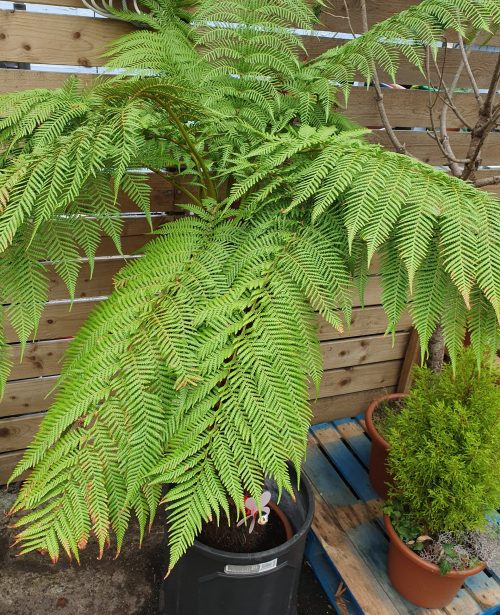
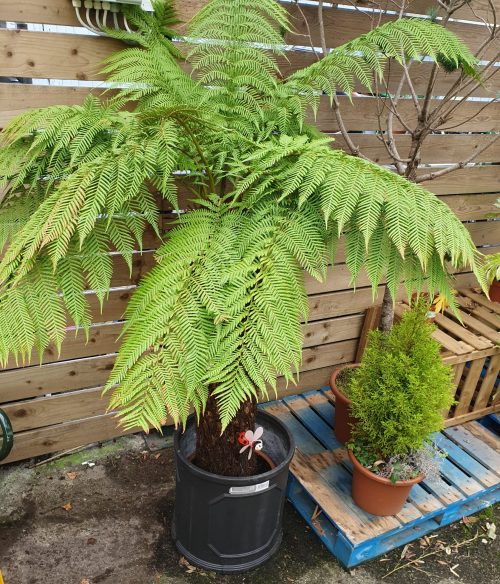 Native to coastal parts of Australia, Dicksonia antarctica is a magnificent, slow-growing, evergreen tree-fern (deciduous in colder areas) and one of the easiest to grow. The brown, fibrous ‘stem’ slowly grows taller, crowned by a rosette of beautiful, glossy, deep green fronds up to three metres long – a wonderfully architectural plant. Winter protection essential in all but the mildest areas – wrap the top of the ‘stem’ in fleece and protect the growing point in the crown with straw or similar insulation, and if pot-grown, bring inside or insulate the pot. Water the stem in hot weather; do not water the crown in winter. Site: Sheltered, sheltered coastal Soils: Moist but well-drained, acid to neutral soil Position: Partial shade or dappled shade Season of interest: Most of the year Hardiness: Frost-hardy Height to 13’ (4m) Spread to 13’ (4m)
Native to coastal parts of Australia, Dicksonia antarctica is a magnificent, slow-growing, evergreen tree-fern (deciduous in colder areas) and one of the easiest to grow. The brown, fibrous ‘stem’ slowly grows taller, crowned by a rosette of beautiful, glossy, deep green fronds up to three metres long – a wonderfully architectural plant. Winter protection essential in all but the mildest areas – wrap the top of the ‘stem’ in fleece and protect the growing point in the crown with straw or similar insulation, and if pot-grown, bring inside or insulate the pot. Water the stem in hot weather; do not water the crown in winter. Site: Sheltered, sheltered coastal Soils: Moist but well-drained, acid to neutral soil Position: Partial shade or dappled shade Season of interest: Most of the year Hardiness: Frost-hardy Height to 13’ (4m) Spread to 13’ (4m) -
Out of stock
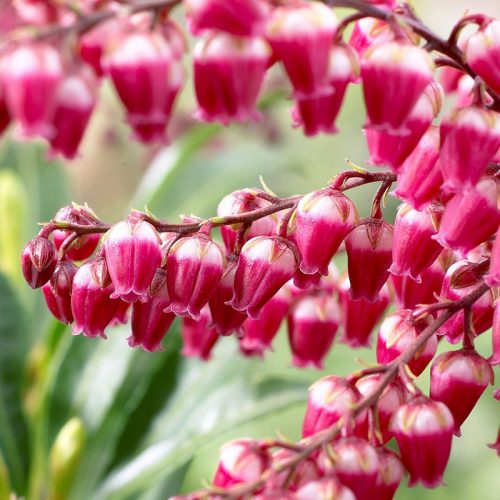
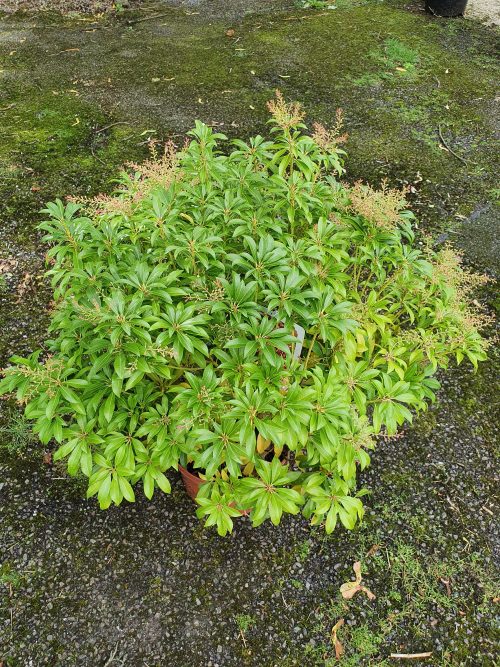 Reaching up to around a metre tall and wide, the attractive foliage is variegated in creamy white or even light yellow. The show stopping flowers are the real star and what makes this plant unique, being the first ever variegated Pieris variety to carry the masses of lily-of-the-valley-like flowers in deep red-purple. The plant is attractive in bud as they form over several weeks, to burst out in all their glory in Spring, lasting for several weeks. Later on, new shoots on the plant are produced in vivid shades of burgundy-scarlet-red, making for season long interest, and a real winner of an evergreen plant for the patio or garden. The blooms even carry a light fragrance. This Pieris is perfect for a mixed border among dwarf conifers, combined with other shrubs and evergreen, or it will simply also look great in a large pot on a patio.
Reaching up to around a metre tall and wide, the attractive foliage is variegated in creamy white or even light yellow. The show stopping flowers are the real star and what makes this plant unique, being the first ever variegated Pieris variety to carry the masses of lily-of-the-valley-like flowers in deep red-purple. The plant is attractive in bud as they form over several weeks, to burst out in all their glory in Spring, lasting for several weeks. Later on, new shoots on the plant are produced in vivid shades of burgundy-scarlet-red, making for season long interest, and a real winner of an evergreen plant for the patio or garden. The blooms even carry a light fragrance. This Pieris is perfect for a mixed border among dwarf conifers, combined with other shrubs and evergreen, or it will simply also look great in a large pot on a patio. -
Out of stock
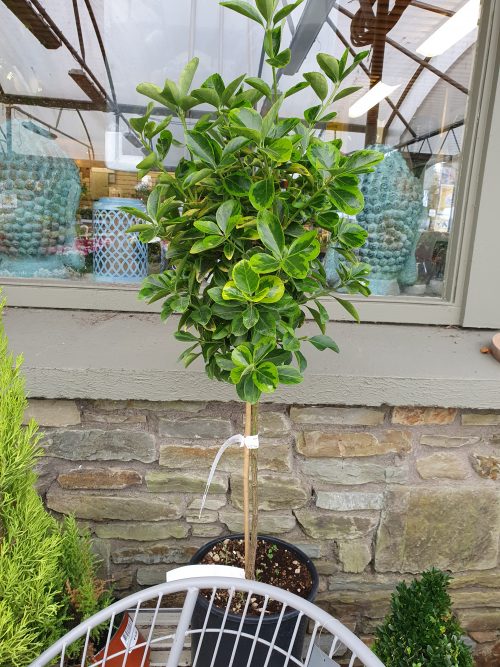
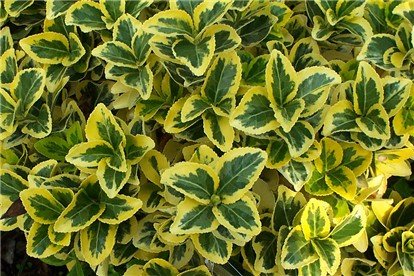 Euonymus japonicus Aureus is an evergreen variety and provides year round interest. Excellent for growing as a specimen shrub or small hedge. Also suitable for coastal areas. The attractive leathery leaves are dark green with bright yellow edges.A Decorative Foliage
Euonymus japonicus Aureus is an evergreen variety and provides year round interest. Excellent for growing as a specimen shrub or small hedge. Also suitable for coastal areas. The attractive leathery leaves are dark green with bright yellow edges.A Decorative Foliage- Pot size: 7.5L
- Height: 4m
- Spread: 2m
- Leaf colour: variegated
- Plant location: sunny
- Plant depth: 15 cm
- Hardiness: -15 Celsius
- Harmful if eaten
- Preferred soil: Grows in any soil
-
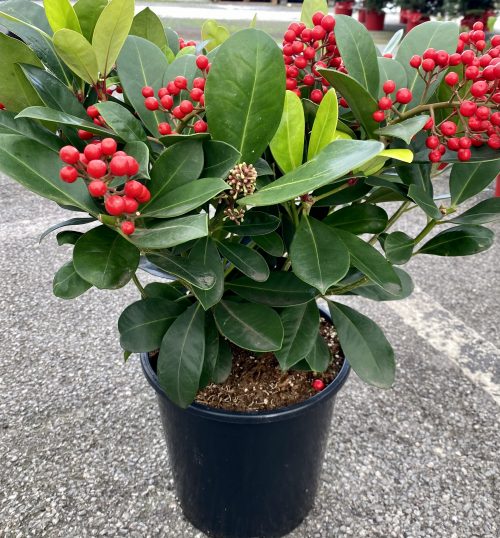 Skimmia Japonica 'Chameleon' has beautiful red berries right up to March/April and then white flowers will bloom for the summer. Perfect in sun or shade and can be kept in a pot or planted into the ground.
Skimmia Japonica 'Chameleon' has beautiful red berries right up to March/April and then white flowers will bloom for the summer. Perfect in sun or shade and can be kept in a pot or planted into the ground. -
Out of stock
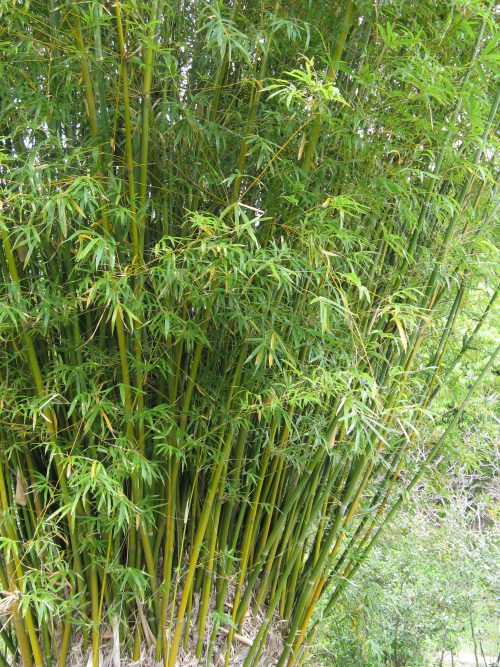
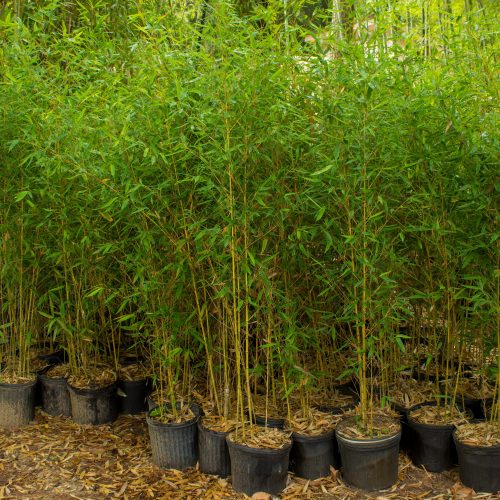 Phyllostachys are the most common of the bamboos, tall, clump forming but not invasive and evergreen, the aurea are large with bright green stems that yellow with age. Grows tall up to 4 metres and clumps well in a sheltered position. Makes an unusual but effective hedge.
Phyllostachys are the most common of the bamboos, tall, clump forming but not invasive and evergreen, the aurea are large with bright green stems that yellow with age. Grows tall up to 4 metres and clumps well in a sheltered position. Makes an unusual but effective hedge.- Size: 12 litre pot
- Actual size: 150-175cm
- Mature Height : 4m - 8m
- Mature Spread : 2m - 2.5m
- Flower Colour : None or Insignificant
- Flowering Time : None or Insignificant
- Foliage : Evergreen
- Fragrant : No
- Growth Rate : Fast
- Hardiness : Fully Hardy
- Position : Full sun, Partial shade
- Soil Moisture : Moist Well-drained
- Soil PH : Acid, Neutral, Alkaline
- Soil Type : Loam
-
Out of stock
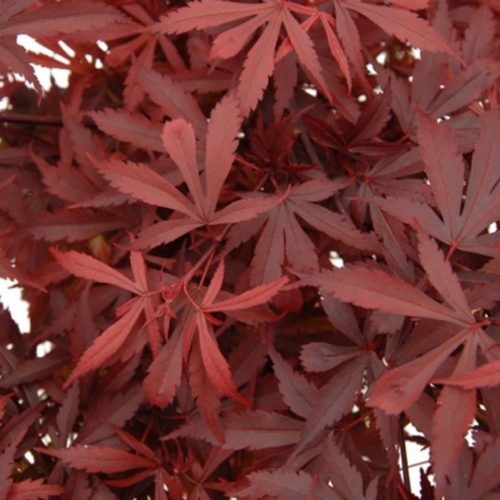 A small deciduous tree that has been in cultivation in Japan for a very long time. The fresh, delicate looking foliage is almost transparent in the sunlight and the overall shape of Japanese Maples make them an excellent choice as a specimen tree in a sheltered spot. Acer Palmatum Atropurpureum is the dark purple-leaved form of the common Japanese maple with exceptionally great Autumn colour. Growing notes: Acer palmatum and its cultivars are slow growing and do not really require pruning, but will tolerate it if necessary - remove damaged, diseased or crossing branches - it is best done during the dormant months. Lower branches can be taken off to shape the canopy over time. Japanese maples all require shelter from wind to avoid wind scorch. The very fine leaved cultivars need extra protection from wind and the sun. Despite being hardy, the fresh growth can be vulnerable to frost in the Spring. They all tolerate growing in a large container, some for a very long time.
A small deciduous tree that has been in cultivation in Japan for a very long time. The fresh, delicate looking foliage is almost transparent in the sunlight and the overall shape of Japanese Maples make them an excellent choice as a specimen tree in a sheltered spot. Acer Palmatum Atropurpureum is the dark purple-leaved form of the common Japanese maple with exceptionally great Autumn colour. Growing notes: Acer palmatum and its cultivars are slow growing and do not really require pruning, but will tolerate it if necessary - remove damaged, diseased or crossing branches - it is best done during the dormant months. Lower branches can be taken off to shape the canopy over time. Japanese maples all require shelter from wind to avoid wind scorch. The very fine leaved cultivars need extra protection from wind and the sun. Despite being hardy, the fresh growth can be vulnerable to frost in the Spring. They all tolerate growing in a large container, some for a very long time.- Cultivars with green or yellow foliage are best grown in dappled shade as full sun can scorch the leaves.
- Cultivars with purple or red foliage require some sun to fully develop their dark colour.
- Cultivars with variegated foliage require shade from the afternoon sun to prevent scorching.
-
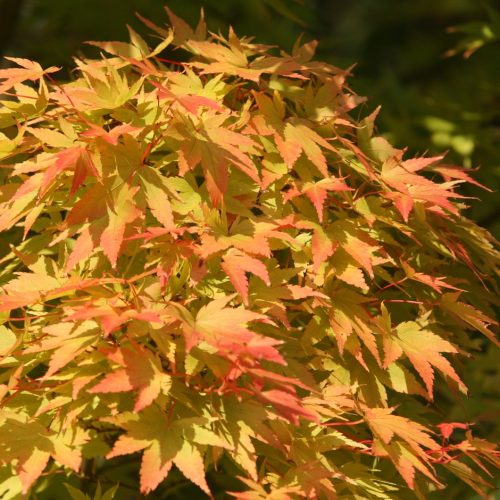 Acer 'Sangokaku' is a compact, bushy acer growing to 5m tall in 10 years. The leaves emerge green in spring, turning a yellow, orange before falling. Pot Size: 5L Plant Size • Mature Height: 5m • Mature Spread: 2m Why We Love It • Perfect as a spciment plant in cottage gardens, city gardens or for rock gardens an containers • Low maintenace What To Know • Season of Interest: Spring-Autumn • Position: Full sun, partial shade • Soil: Moist but well drained, organically rich How to Care • Pruning should be carried out in the dormant season (November to March) as Japanese Maples bleed during other times of the year, which can weaken the branches. • Water in summer if necessary. • Leaf colour is best in partial shade, although full sun can be tolerated. • Add a top-dressing of a well-balanced fertiliser around the base of a recently planted tree in late spring and keep it well watered. No routine pruning is required, just remove any dead, damaged or crossing branches in late autumn or winter when they are fully dormant.
Acer 'Sangokaku' is a compact, bushy acer growing to 5m tall in 10 years. The leaves emerge green in spring, turning a yellow, orange before falling. Pot Size: 5L Plant Size • Mature Height: 5m • Mature Spread: 2m Why We Love It • Perfect as a spciment plant in cottage gardens, city gardens or for rock gardens an containers • Low maintenace What To Know • Season of Interest: Spring-Autumn • Position: Full sun, partial shade • Soil: Moist but well drained, organically rich How to Care • Pruning should be carried out in the dormant season (November to March) as Japanese Maples bleed during other times of the year, which can weaken the branches. • Water in summer if necessary. • Leaf colour is best in partial shade, although full sun can be tolerated. • Add a top-dressing of a well-balanced fertiliser around the base of a recently planted tree in late spring and keep it well watered. No routine pruning is required, just remove any dead, damaged or crossing branches in late autumn or winter when they are fully dormant. -
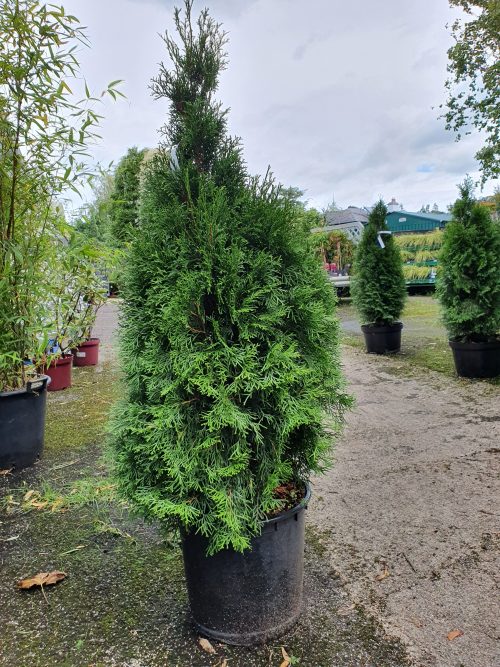 A slow growing, evergreen, erect conifer, Thuja occidentalis Smaragd has scale-like, fresh green leaves that are held closely to the shoots and give a fresh apple-like aroma when crushed. With its narrow, conical shape, Smaragd makes a useful tree for any garden, and is particularly suitable for formal plantings either as an individual specimen or in rows. It is slow to reach its eventual height of around 8-10ft but the narrow, conical shape will broaden out with maturity to reach a diameter of around 6ft. Pot size: 20L Actual height: 100-125cm Site: Very tolerant of inland exposure Soil: Well drained, tolerates clay soils, shallow over chalky soils Position: Full sun, tolerates partial shade Season of Interest: All year round and aromatic foliage Hardiness: Fully hardy Height: 5-8ft (1.5-2.5m) Spread: 3-6ft (1-2m)
A slow growing, evergreen, erect conifer, Thuja occidentalis Smaragd has scale-like, fresh green leaves that are held closely to the shoots and give a fresh apple-like aroma when crushed. With its narrow, conical shape, Smaragd makes a useful tree for any garden, and is particularly suitable for formal plantings either as an individual specimen or in rows. It is slow to reach its eventual height of around 8-10ft but the narrow, conical shape will broaden out with maturity to reach a diameter of around 6ft. Pot size: 20L Actual height: 100-125cm Site: Very tolerant of inland exposure Soil: Well drained, tolerates clay soils, shallow over chalky soils Position: Full sun, tolerates partial shade Season of Interest: All year round and aromatic foliage Hardiness: Fully hardy Height: 5-8ft (1.5-2.5m) Spread: 3-6ft (1-2m) -
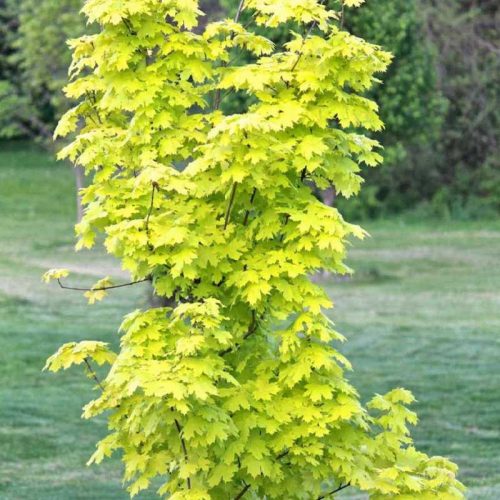 Grow for its bright golden foliage and stately form, Acer platanoides Princeton Gold is a tall, fast-growing, long-lived, deciduous tree with a bushy, broadly columnar habit. Typical five-lobed maple leaves emerge pale gold on red leaf-stalks, turning a rich golden-yellow as the season progresses. Inconspicuous yellowish flowers are followed by winged ‘helicopter’ seeds in autumn. Tough and easy to grow and maintain, Norway Maple Princeton Gold makes a beautiful specimen tree, colouring best in full sun. Site: Tolerates exposure Soil: Any well drained soil, preferably moist Position: Full sun or partial shade Season of interest: Spring to autumn Hardiness: Very hardy Height: Eventually over 40’ (12m) Spread: 26’ (8m)
Grow for its bright golden foliage and stately form, Acer platanoides Princeton Gold is a tall, fast-growing, long-lived, deciduous tree with a bushy, broadly columnar habit. Typical five-lobed maple leaves emerge pale gold on red leaf-stalks, turning a rich golden-yellow as the season progresses. Inconspicuous yellowish flowers are followed by winged ‘helicopter’ seeds in autumn. Tough and easy to grow and maintain, Norway Maple Princeton Gold makes a beautiful specimen tree, colouring best in full sun. Site: Tolerates exposure Soil: Any well drained soil, preferably moist Position: Full sun or partial shade Season of interest: Spring to autumn Hardiness: Very hardy Height: Eventually over 40’ (12m) Spread: 26’ (8m) -
Out of stock
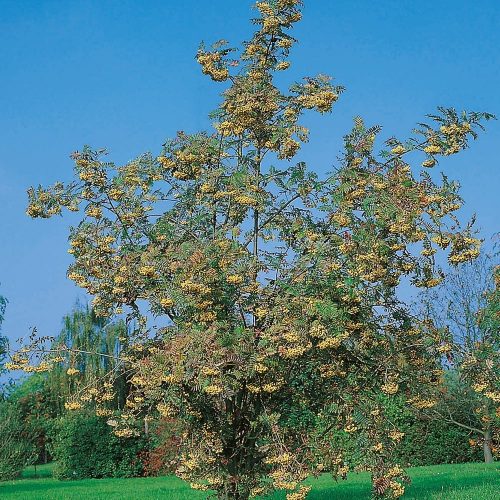
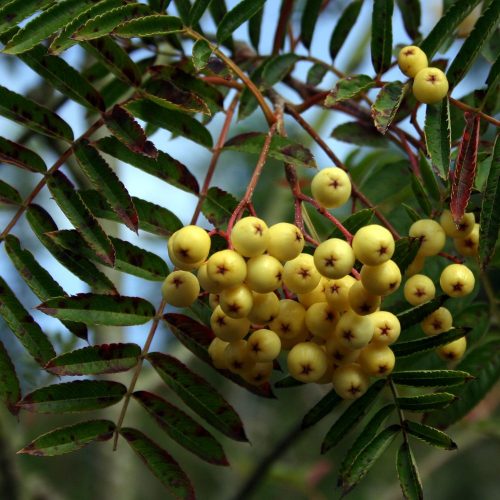 Sorbus Joseph Rock is a bright yellow-berried rowan tree very suitable for the small garden. It remains a great choice as a small tree for the small garden. A First-class tree with small, bright green leaflets that turn orange, purple and red in autumn. Clusters of white flowers appear in spring and are followed in autumn by small yellow berries, which birds love. It is an outstanding small tree which can tolerate a wide range of soils and conditions.
Sorbus Joseph Rock is a bright yellow-berried rowan tree very suitable for the small garden. It remains a great choice as a small tree for the small garden. A First-class tree with small, bright green leaflets that turn orange, purple and red in autumn. Clusters of white flowers appear in spring and are followed in autumn by small yellow berries, which birds love. It is an outstanding small tree which can tolerate a wide range of soils and conditions.- Max. Height & Spread: H-12m x S-8m
-
Out of stock
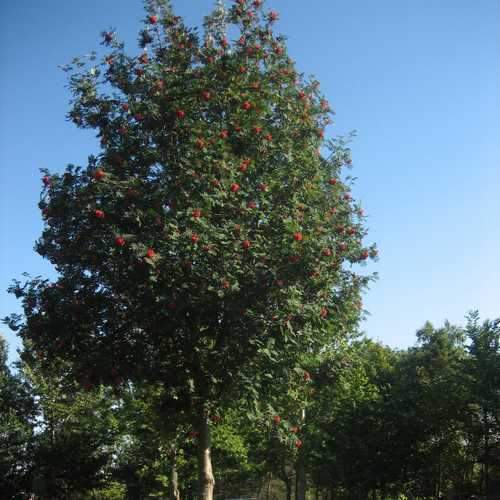
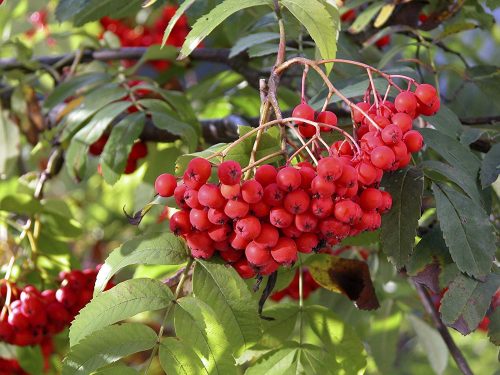 A cultivar of the native Irish rowan or mountain ash, Sorbus aucuparia ‘Sheerwater Seedling’ is a vigorous, medium-sized to tall tree of upright, narrow habit, the crown widening with maturity. It is often planted as a street tree. Creamy-white flowers appear in April–May, reliably followed by large clusters of long-lasting red berries in late summer. The leaves are grey-green, turning yellow and gold in autumn. A very easy, fast-growing, reliable tree, good for pollinators and birds. Plant in full sun for the best shape. Holds the RHS Award of Garden Merit. Site: Tolerates exposure Soil: Any reasonably well drained soil, acid to neutral soils preferred Position: Full sun Season of Interest: Spring, late summer, autumn Hardiness: Fully hardy Height: 40’ (12m) Spread: 13-26’ (4-8m)
A cultivar of the native Irish rowan or mountain ash, Sorbus aucuparia ‘Sheerwater Seedling’ is a vigorous, medium-sized to tall tree of upright, narrow habit, the crown widening with maturity. It is often planted as a street tree. Creamy-white flowers appear in April–May, reliably followed by large clusters of long-lasting red berries in late summer. The leaves are grey-green, turning yellow and gold in autumn. A very easy, fast-growing, reliable tree, good for pollinators and birds. Plant in full sun for the best shape. Holds the RHS Award of Garden Merit. Site: Tolerates exposure Soil: Any reasonably well drained soil, acid to neutral soils preferred Position: Full sun Season of Interest: Spring, late summer, autumn Hardiness: Fully hardy Height: 40’ (12m) Spread: 13-26’ (4-8m) -
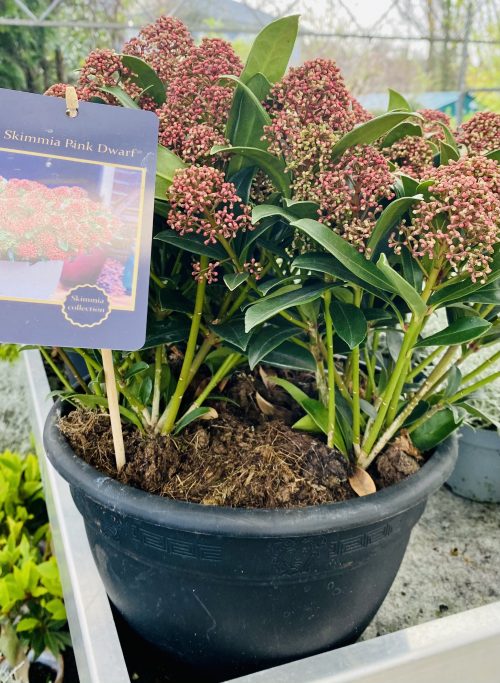 The Pink Dwarf is a compact growing Skimmia. Pink flower buds form in the autumn and and open to reveal pale pink flowers between March and May. Place in full sun/shade.
The Pink Dwarf is a compact growing Skimmia. Pink flower buds form in the autumn and and open to reveal pale pink flowers between March and May. Place in full sun/shade.